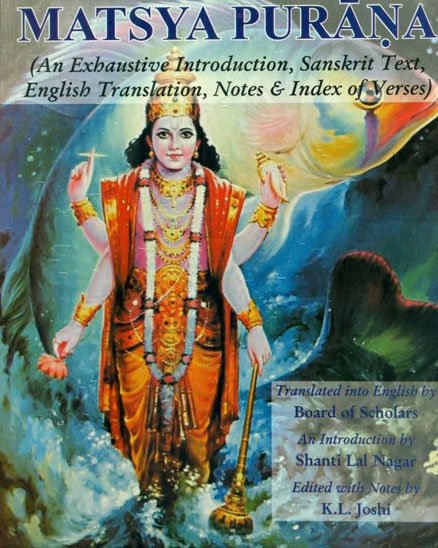The Matsya Purana (critical study)
by Kushal Kalita | 2018 | 74,766 words | ISBN-13: 9788171103058
This page relates ‘Matsyapurana: an introductory note’ of the English study on the Matsya-purana: a Sanskrit text preserving ancient Indian traditions and legends written in over 14,000 metrical verses. In this study, the background and content of the Matsyapurana is outlined against the cultural history of ancient India in terms of religion, politics, geography and architectural aspects. It shows how the encyclopedic character causes the text to deal with almost all the aspects of human civilization.
Part 2 - Matsyapurāṇa: an introductory note
The Matsyapurāṇa is a voluminous Purāṇa having 14,062 stanzas in 291 chapters according to the Anandashram Press edition. Amongst the 18 Mahāpurāṇas, the Matsyapurāṇa, the Vāyupurāṇa and the Brahmāṇḍapurāṇa are regarded as the most ancient Purāṇas. According to M. Winternitz, the Matsyapurāṇa is one of the older works of the Purāṇa literature. The Matsyapurāṇa is at least one of those Purāṇas which have preserved most of the ancient text.[1] P. V. Kane holds the view that it is the earliest of the eighteen Purāṇas and is best preserved.[2] Vāmanapurāṇa also gives it the status of the chief Purāṇa among all other Purāṇas.49 The Vāyupurāṇa[3] and the Devībhāgavatapurāṇa[4] assign the first place to the Matsyapurāṇa. P. V. Kane compares Matsyapurāṇa with a Dharmaśāstra.
In the History of Dharmaśāstra, he opines,
“Matsyapurāṇa is pre-eminently a work containing much Dharmaśāstra material.”[5]
In this way, it is seen that the Matsyapurāṇa occupies an important place in the Purāṇic literature.
The origin of this Purāṇa is covered in mystery just like other ancient Sanskrit texts. While describing the origin of it, the Matsyapurāṇa says that the God in the form of fish, i.e., Matsya, appeared before Manu, the father of mankind when the world was about to deluge revealed in this Purāṇa. This Purāṇa is so named as Lord Viṣṇu, in the form of Matsya (Fish) narrates its story.[6] Also regarding the naming of the Purāṇa the account of the narration of the Flood-legend in the first two chapters of the Matsyapurāṇa can be taken account of. It was on this occasion that Lord Viṣṇu assumed the form of the Fish and towed Manu’s boat to a safe place at the time of the deluge which resulted in a partial dissolution of the world and not in its total annihilation.
V. R. Ramachandra Dikshitar, on the other hand, has remarked in his work that the origin of Matsya or tribe in the name of Matsya, was survived long back from the days of the Ṛgveda who ruled an independent kingdom.[7] He has again mentioned that in the Śatapathabrāhmaṇa also, there is the description of a Matsya king named Dhvasan Dvaitavana. Thus it may be possible that this Matsya tribe is the home of the origination of this Purāṇa i.e., Matsyapurāṇa.
Footnotes and references:
[1]:
Cf., M. Wintenitz, A History of Indian Literature, Volume I, p. 575
[2]:
[3]:
Vāyupurāṇa, 104.3
[4]:
Devībhāgavatapurāṇa, 1.3.3
[5]:
P. V. Kane, History of Dharmaśāstra, Volume IV, p. 899
[7]:
Cf., V. R. Ramachandra Dikshitar, The Matsya Purāṇa-A Study, p.20
